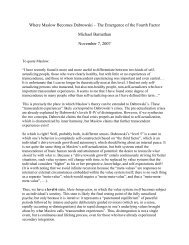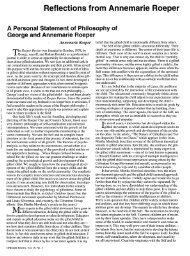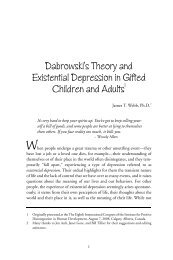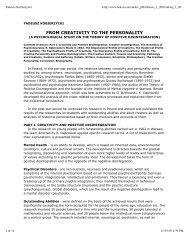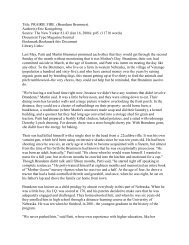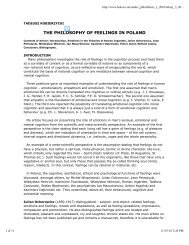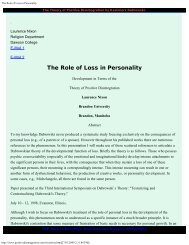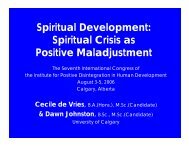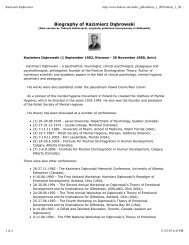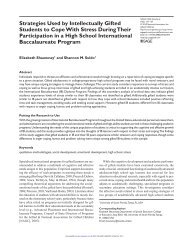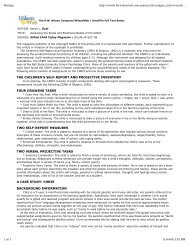Patterns of Overexcitability Overexcitabilities - Kazimierz ...
Patterns of Overexcitability Overexcitabilities - Kazimierz ...
Patterns of Overexcitability Overexcitabilities - Kazimierz ...
You also want an ePaper? Increase the reach of your titles
YUMPU automatically turns print PDFs into web optimized ePapers that Google loves.
Downloaded By: [Canadian Research Knowledge Network] At: 21:10 26 March 2011between gender and grade level, F(2,288) = 3.03, p < .05, suggesting that therelationship between gender and the OEschanges for gifted students in elementaryand middle school. A histogramillustrates the dramatic decline in meanImaginational OE scores for giftedfemales and the widening gap betweengifted males and females on the EmotionalOE in elementary and middleschool (Figure 2).Summary <strong>of</strong> ResultsIn summary, there were significantdifferences between males and females,elementary- and middle-school students,and typical and gifted students on thecomposite OE subscales. Females scoredsignificantly higher on the Emotionaland Sensual OE subscales than males.The mean OE scores for femalesdropped for elementary- and middleschoolstudents on each <strong>of</strong> the OE subscaleswith the exception <strong>of</strong> theEmotional OE. Mean Psychomotor OEscores were significantly higher overallfor elementary-school males thanfemales. Mean OE-subscale scores wererelatively stable for typical students(mean differences less than .17), but variedgreatly for gifted students. There wasa significant interaction between gradelevel and gender and GT status. Gifted,elementary-school students scored higheron all five OE subscales while typical,middle-school students scored higher onthe Sensual and Imaginational OEs.There was a significant decline in meanSensual and Imaginational OE scores forgifted, middle-school students whencompared to their elementary peers.DiscussionResults from this study support earlierresearch on potential differencesbetween males and females, and typicaland gifted students on the OE subscales.There is also evidence <strong>of</strong> a departurefrom the conventional wisdom regardingthe OEs and gifted students. Finally,there are new and important issues to beraised as a result <strong>of</strong> the examination <strong>of</strong>similarities and differences between gender-and grade-level groups.GenderThe small amount <strong>of</strong> research thathas been conducted thus far on genderdifferences has focused exclusively ondifferences between gifted females andmales. In this study, males and femalesFigure 1Figure 2Means on the Subscales <strong>of</strong> theOEQII forAll Students by Gender and AgeH ElementaryMales13 Middle SchoolMalesllementaryFemales1 Middle SchoolFemalesMeans on the Subscales <strong>of</strong> theOEQII for Gifted Students by Gender and Agediffered significantly on two OE subscales,Sensual and Emotional, whichmirrors earlier results from samples <strong>of</strong>gifted students. Additionally, males hadhigher Psychomotor OE scores withinthe general sample and each <strong>of</strong> the subgroups(typical and gifted); however, thedifference was greater for typical malesand females than for their gifted peers,''he most interesting results deriveT, from examining the differencesin pr<strong>of</strong>iles <strong>of</strong> males and females in elementaryand middle school. For males,their OE-subscale scores decline fromelementary to middle school for each OEexcept Intellectual, which is higher inmiddle-school students. This may be theresult <strong>of</strong> an increased focus on content inthe middle-school classroom as opposedto a focus on skills instruction in the elementary-schoolclassroom. Females generallyoutperform males in readingduring elementary school. This maycatch up with middle-school boys asthey struggle with complex curriculumthat relies heavily on reading ability.Females, on the other hand, have lowerI ElementaryMales/liddle SchoolMalesElementaryFemales3 Middle SchoolFemalesmean OE scores in middle school on allsubscales except Emotional, which ishigher for middle-school females. Thismay be due to developmental changesoccurring for females at the time or tosocial and cultural stereotypes aboutfemales and emotionality.In examining gender differencesbetween typical and gifted students,different patterns emerge. First,typical males have higher mean PsychomotorOE scores than gifted males,which contradicts earlier studies thatsuggest that the Psychomotor OE maybe the best predictor <strong>of</strong> giftedness (Ackerman,1997; Tieso, in press). Giftedmales have higher mean scores on all <strong>of</strong>the other OE subscales, which supportsearlier research (Ackerman). In examiningthe mean differences between typicaland gifted females, the gifted studentshad higher mean scores on all <strong>of</strong> the OEsubscales except Sensual. This may bethe result <strong>of</strong> increased awareness <strong>of</strong> others'perceptions <strong>of</strong> them as gifted individuals.Researchers have suggested thatgifted students in general, and gifted236/Roeper Review, Vol. 29, No. 4



